
iStudy for Success!
Online learning tutorials for essential college skills.
iStudy would like to acknowledge Glenna Emel for revising this tutorial's content.
Students come to college with different expectations for their particular college experience. Some arrive with a clear goal of obtaining a degree. Other students simply enjoy learning and see the opportunity to learn in an atmosphere created for that very purpose as an important part of earning their degree. Others expect college to be a time to have fun, make new friends, and enjoy life without parental supervision, while some students are parents themselves, work full-time, or have other adult responsibilities and obligations.
Whatever your expectations, the reality is that being able to plan and prioritize activities is an important skill to obtain so that you can complete class assignments and projects on time without denying yourself a social life, recreational activities, or other items that are important to you.
You will find some classes require more time than others. Studies have shown that the recommended "prep time" for every hour spent in class is two to three hours a week. This means taking fifteen credits will require between fourty-five to sixty hours a week to attend class and keep up with assignments and studying. This work load is heavier than that of many full-time jobs. In addition to study requirements, extra-curricular activities affect leisure time as well. Both families and jobs also come with additional time constraints.
Time management is a major concern for most of us. For a student, managing time has its own special twists and turns that have to be negotiated. Time management helps you to meet deadlines and be responsible. It helps you fit all the different pieces of your life together and complete class assignments and projects without the added stress of an approaching deadline.
There will be times when you have multiple exams or class projects scheduled for the same day. Developing your time management skills by learning a few time management techniques will help you plan for events that you can foresee and cope with those you cannot.
This tutorial addresses academic survival skills and provides opportunities for information gathering, synthesis, and analysis in solving problems and in critical thinking. The overall goal of this tutorial is to introduce you to time management terminology and concepts. Once you finish this tutorial, you will be able to:
Below is the recommended sequence for completing this tutorial:
Note: All external links in this tutorial will open in a new window or tab.
Sound familiar? The good news is that there is enough time for the things you want to do, but only if you learn to manage your time wisely.
In high school, you got up at the same time everyday and you probably went to school from about 8 AM to 3 PM. You basically had no say in where your time was spent. Now that you are in college your schedule is your responsibility. So what do you do? Study or have fun? These decisions are easier to make with the use of a few techniques to better manage your time.
Deena: Brian, why do you think you need help managing your time?
Brian: Well, I came here expecting college to be a time for having fun, making new friends, experiencing life without Mom and Dad's nagging, and getting a degree. But, now I feel really pressured and I don't seem to have enough time to get anything done. I just don't know how you manage your time, what with the family, the farm, group meetings, and the community activities in which you are involved.
Deena: Well, it hasn't been easy. I have a new respect for what my husband has to do when planning for our farm operation – especially now that I am in school. You know, if you are feeling frustrated or upset, you may want to focus on learning to manage your time and take control of your life as a college student.
Brian: Yeah!
Deena: Okay, time for a reality check. As it turns out, for every hour I spend in class, I need about two to three hours of preparation. That includes assignments, of course, but it also includes preparing for lectures or other school-related activities. How many credits do you have this semester?
Brian: Fifteen.
Deena: That's a lot when you consider that for each credit it takes two to three hours to attend class and keep up with the work. Let's see, hmmmm . . . you need 45 hours a week just for schoolwork.
Brian: And don't forget, I need time to relax, and sometimes, I like to visit with my family.
Deena: That's right. That's important for your well being as well as your social life. Your folks like to know you're alive and well too.
Brian: I need time to sleep...
Deena: Right.
Brian: Well, how are we going to make time for everything?
Deena: We'll be getting to that in a minute. First, I want you to take a few minutes to think about the activities and responsibilities that demand your time outside of the classroom.
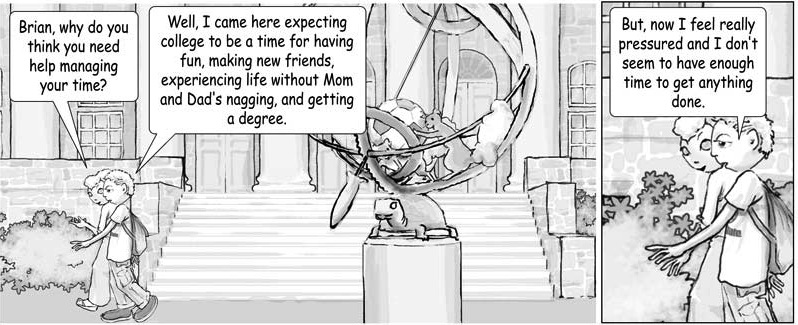
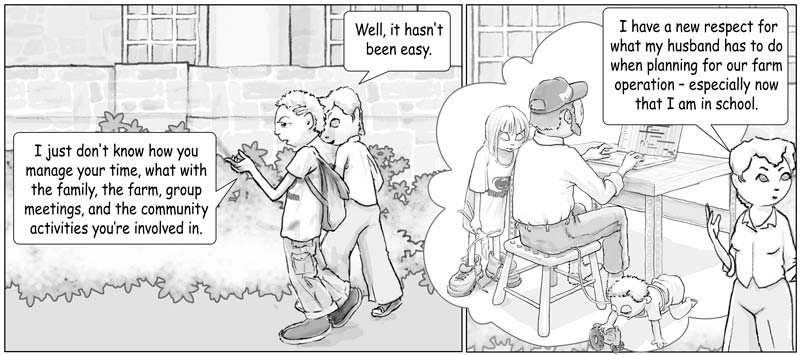
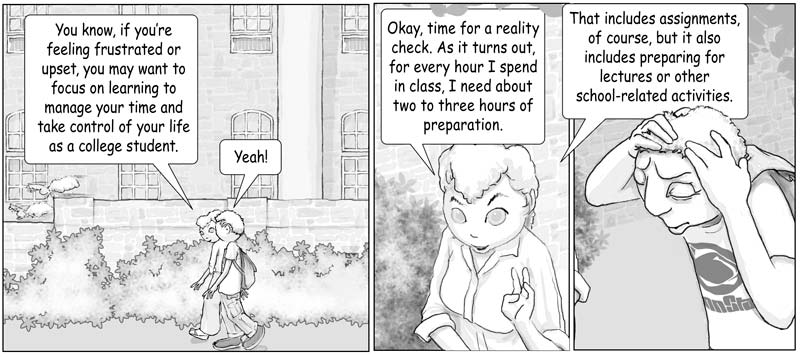
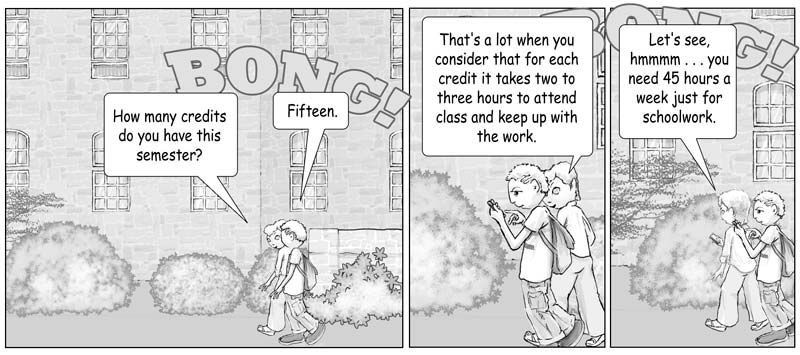
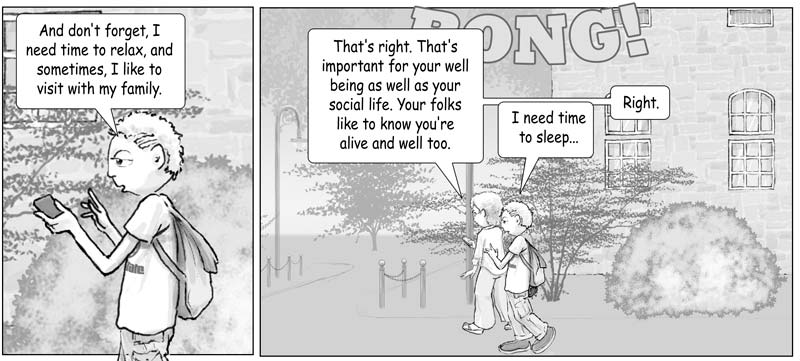
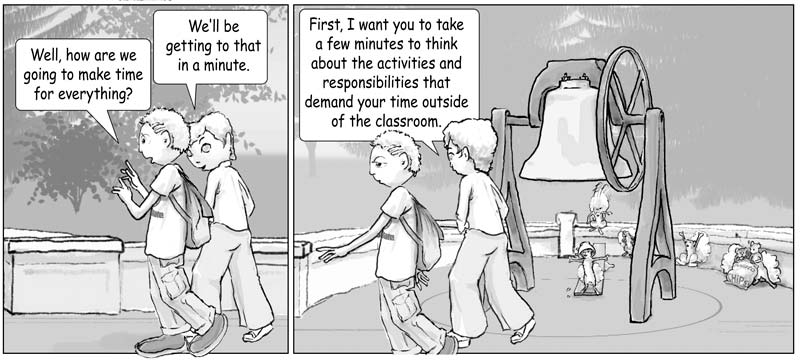
[top of page]
One of the hardest things about managing time is determining priorities, especially when those priorities are associated with activities you really like to do, and other activities that are very low on your list of favorites.
Here are some ideas of categories for setting priorities:
By using these categories, or categories like these, you can conceptually start with a blank slate, and then "insert" activities according to their priorities.
Think about the activities you do every week. Complete the two worksheets listed below by filling in your activities in the appropriate columns. At the same time you are prioritizing your activities and filling in the first worksheet, consider and answer the questions on the second exercise.
Note: A downloadable RTF of this worksheet is included in the left sidebar of this page.
|
Daily & Required |
Periodic & Required |
Variable & Required |
Recommended |
Planning/ Reflection |
Unplanned/ Emergency |
|
|
|
|
|
|
|
Answer the following questions to help you understand your own likes and dislikes as you set your priorities. Ask yourself the following questions, and then answer them honestly.
Note: A downloadable worksheet in RTF format is included in the left sidebar of this page.

Complete this exercise to help you assess how you are doing right now with time management. You may want to add this to the end of your Self-Analysis Worksheet. Before you think, "This is dumb!" please note that self reflection is a key to success no matter what your chosen career. Consider Alice in Wonderland:
Alice: Would you tell me, please, which way I ought to go from here?
The Cat: That depends a good deal on where you want to get to.
Alice: I don't much care where. (Not ANY self reflection!)
The Cat: Then it doesn't much matter which way you go.

Having done a quick weekly estimate of how you spend your time in the previous activity, write a paragraph or two about your current status related to managing time. What are the constraints you are experiencing? How have your time management issues changed now that you are enrolled in college? How do you currently feel about the way you are dealing with the demands on your time?
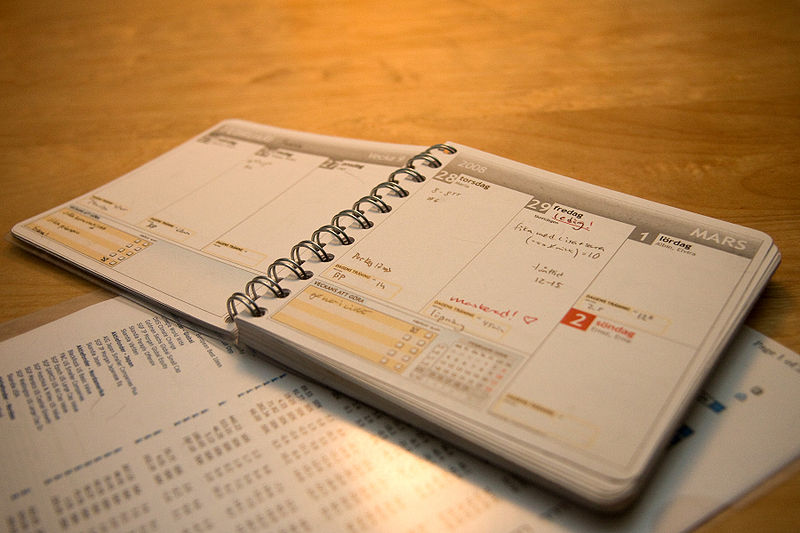
Now that you have started to think about all the activities and responsibilities that demand your time, you need to actually assign numbers to these activities. Estimate the time you spend on these activities during one week. Look at the worksheet you completed in the previous activity. Make an additional table like the one shown below. List every extra-curricular activity and responsibility you have. Next to each entry, estimate the time you'll designate to these activities and responsibilities. Total the estimated time column.
|
Extra Curricular |
Estimated Time (hours) |
|---|---|
|
Work |
20 |
|
Rehearsals |
6 |
|
Racquetball |
4 |
|
Goofing Off |
14 |
|
TOTAL Extra Curricular |
44 |
Next, look at your curricular or in-class activities and preparation time, and make two entries: one for the number of hours you spend in class weekly and another for preparation time (which is the number of in-class hours multiplied by 2 or 3). Total the estimated time column.
|
Curricular |
In-class |
Prep Time |
Estimated Total Time (hours) |
|---|---|---|---|
|
English Literature |
3 |
6-9 |
9-12 |
|
Art History |
3 |
6-9 |
9-12 |
|
Chemistry |
3 |
6-9 |
9-12 |
|
Chemistry Lab |
1 |
2-3 |
3-4 |
|
Psychology |
3 |
6-9 |
9-12 |
|
TOTAL Curricular |
13 |
26-39 |
39-52 |
Total your estimated hours for both curricular and extra curricular activities.
Deena: Brian, how is your list coming along? You mentioned sleep. How many hours did you allow for sleep each week?
Brian: Oh, about five hours a night, so about thirty-five hours. But, sometimes I'm so tired that I can't help but fall asleep in class.
Deena: No! Now, even you know that isn't a good way to spend your time in the classroom. You should be actively listening and taking notes. I know each person has different needs for sleep, but I think you should allocate about eight hours each night.
Brian: That's fifty-six hours!
Deena: Right! Cutting back on sleep isn't a very good time management strategy. Sleeping is also a necessity! Add the average number of hours you sleep per night; or day, or whenever you do your sleeping to your total. Many experts recommend eight hours of sleep per night.
|
Sleep |
8 |
|
TOTAL Estimated Sleep per Week |
56 |
There are 168 hours in one week. The sample worksheets show that 56 hours have already been estimated for sleep, leaving just 112 to be allocated.
You may not be surprised by the totals you see in your own estimated time logs. Others will be amazed, frustrated, or feel as though things are totally out of their control.
Here's another way to look at how you spend your time. Open this time estimator in a new window or tab. Mark the average hours per day or hours per week spent doing the activities on the left. While filling this out, think about where most of your time is wasted. Click the "Total Hours Allotted" button to calculate how many hours you spend on activities each week. The time remaining total will automatically update to show the amount of time that could be used for studying per week. Close the new window or tab when you are finished.
 Deena: I can show you four steps that will help you develop your time management skills. Are you ready to get started?
Deena: I can show you four steps that will help you develop your time management skills. Are you ready to get started?
Brian: Yes, let's get started.
Deena: The first step is to determine your long-term goals. To complete this step, you will need to complete several tasks.
Brian: Great, just what I need, more work to do.
Deena: Well, if this is going to work for you, you have to put some work into it.
Brian: I know.
If you haven't completed the Writing and the College Experience iStudy Tutorial, complete these two activities now to get started thinking about your long-term goals.
Do some reflecting on your family history - think of your family's background as the recipe for how you came to be you or take a look at some memorabilia you have in your room or in your wallet. A photo, artifact, or your family background can serve as a starting point. So, begin with a single photograph or something you saved in a scrapbook. Follow the thoughts these frameworks create for you, and allow those thoughts and associations to guide you. There are many ways to start conceptualizing your story. Think of things to start with that will help connect one part of your life to another and give your autobiography a meaningful context.
For instance, if you select a photograph, think about:
Who is in the picture?
Who took it?
Where it was taken?
How old you were?
How this scene relates to your life now?
What else you remember or think about when you look at this picture?
Invite yourself to question the "normal" or habitual ways that you think, so that you can go beyond the obvious in your autobiography. This way of thinking and creating meaning will help you develop strategies for asking different kinds of questions about the writing, reading, and learning you are doing. Remember, different ways of presenting things and looking at things help you as a writer and as a learner.
After spending some time thinking, write down a list of your ideas.
Thinking about what will happen when you "grow up" sounds a little childish perhaps, but many adults, even middle-aged adults, still contemplate who they are now and what they want to be when they grow up. One of the most common reasons for attending college is to prepare for, or make a change in, a vocation or career. Consequently, another approach to constructing an autobiography stems from thinking about careers and future work, versus thinking solely about the past. This autobiographical writing assignment will serve several purposes. For example, by writing this autobiography while thinking about the kind of work you want to do after college, you will be able to complete your writing task and be better prepared for the workplace by better understanding the field or profession.
For this activity, look ahead to the future. Use your intended profession or major as a starting point to consider who you will be or want to be in a few years. As you think about the kind of work you would like to do, you may want to set up an interview with someone already in that field. This could be someone local, someone recommended by your instructor, a business person in the area, or someone you find using an electronic resource. For example, do a Web search and check out the home pages of businesses or personal pages. Then, use the telephone to contact someone whose work matches your interests. You could even use e-mail to electronically interview someone long distance.
As you think through your plans for the future, consider these plans as a part of your autobiography, the "you" of the future is as important to include as the "you" of the present and past. Your anticipated occupation will help shape how you experience college, how you maximize the benefits of college, and who you expect to be. In a sense, you are projecting your autobiography into the future and giving symmetry to the autobiography and experiences you already have.
Use a word processing program to write a description of your career plans, your major, and people you have talked with who do the kind of work you plan to do. Think about why you want to be in this field or profession. How do people who actually do this kind of work feel about it?
Jot down your long-term goals and campus, community, or other resources that are available to you to help you accomplish them. List as many goals and resources as you wish.
|
Goal Resources: |
Deena: The next task is a little more focused. You want to ask yourself the question, "What goals do I want to achieve between now and the end of the semester?"
Brian: That's an easy one. Just get done with it!
Deena: We all want to do that. But, you need to reflect on your answer to the question about why you are in college.
Brian: What if I'm here because my parents want me here?
Deena: I can't help you with that.

The second part of determining your goals is to take a look at your goals for the semester. Wherever you are in the semester, take a moment to determine what you want to accomplish before it is over. At the same time, keep in mind why you are in college and what values are articulated in your reason for being in college. List as many goals as you wish.
|
Semester Goals: Reminder - Why I am in College: Values Articulated in My Reason(s) for Being in College: |
The third task is to determine what obstacles may be in your way. Basically, you must ask yourself how you will go about accomplishing your semester goals given your skills, resources, and abilities. Then, examine each obstacle and try to envision it as a successful milestone or marker for that goal. You might also want to do the same thing for your long-term goals.
Note: A downloadable version of this worksheet in RTF format is included in the left sidebar of this page.
|
Semester Goals |
Obstacles |
Skills/Abilities |
Other Resources |
|
|
|
|
|
|
|
|
|
|
|
|
|
|
|
|
|
|
|
|
|
|
|
|
|
|
Long-term Goals |
Obstacles |
Skills/Abilities |
Other Resources |
|
|
|
|
|
|
|
|
|
|
|
|
|
|
|
|
|
|
|
|
|
|
|
|
|
 Brian: There seem to be a lot of obstacles in the way of my setting goals.
Brian: There seem to be a lot of obstacles in the way of my setting goals.
Deena: What kind of obstacles?
Brian: Well, the first is finding enough time to do this. I mean, finding the resources, determining goals, and thinking!
Deena: Well, if you are to make the most of your college experience, at some point you're going to have to think!
Brian: You're right! I do want to get the most for the money I'm spending for my education. So, where can I find the time to think about this?
Deena: How about when you are walking between classes?
Now that you have outlined obstacles and thought about how they relate to your abilities and resources, take another moment to write a couple of paragraphs summarizing what you have learned.
The reason for articulating goals and identifying obstacles is to develop a strategy for achieving your goals. For example, one of your semester goals might be to accumulate twenty hours of community service during the semester that will count toward the eighty hours required for admittance to your degree program. Obstacles to this goal may include not being familiar with the local community as well as finding the time between now and the end of the semester. One strategy might include a visit to your advisor to talk about what opportunities might be available.
Try developing your own strategies for the goals and obstacles you have identified. List the strategies for overcoming the obstacles for each goal.
|
Goal: Obstacle(s): Strategy/Strategies: |
Often there is a heavy emphasis on planning your time. In the activity at the beginning of this tutorial, you estimated how much time you spend on each activity. Now, it would be a good idea to see if your estimates are accurate.
A useful exercise when beginning to think about better time management is to record how you use your time, and then analyze it. Download and print the following worksheets:
Time Record Worksheet (RTF)
Time Analysis Worksheet (RTF)
You might want to use the first worksheet, which is blocked out into half-hour time slots starting at 6:30 A.M., or develop one that suits your own preferences, to record your time and then analyze how it is being used. A similar method can be very effective for finding out where you spend your money and what you eat all day. You might be extremely surprised about where you actually spend your time compared to where you thought you were spending it.
Before you begin keeping your record, do two things:
1. Develop a set of codes or categories for subsequent study of your time usage. For example:
C = Class Time
W = Work
S = Study
Z = Sleep
T = Travel
You might want to break Class Time down into the specific classes so that you will be able to analyze which class or classes demands the most time. You'll have to experiment a little to see what works best for your personal circumstances.
2. On your weekly time table, estimate how long you intend to spend, or think you should spend, on each activity. Then, record the actual time spent.
Once you have recorded your time over whatever period you decide to use, reorganize and summarize that time in the second worksheet. The second worksheet will use the code set you developed to chart each category by day, total time spent, and estimated time. You will then be able to compare estimates with actual time spent, and see the total time you are spending by day and category.
Brian: So, now that I have determined my goals and listed the obstacles to them, I can get on with the timetable, right?
Deena: Before we do that, there are a couple of tasks we need to finish. First, you need to gather some materials if you don't already have them. Here is a list of what you need. When you have these materials, I'll help you get started with a semester calendar. Okay?
Brian: Okay! Then, I'll see you later.
Materials Brian needs to gather:
Now that you have spent some time thinking about your goals and the obstacles that you will need to overcome, let's think about how you will use the time available to you to reach your goals.
Time management begins with the use of a calendar or planner, daily lists, and taking the time to write down everything that you must do so that it gets done. If you sleep seven hours a night, you have 119 hours a week left to allocate to the things you need to do. That, of course, includes everything from going to class to eating, attending athletic events and social activities, studying, etc. Schedule everything that you must do within the 119 hours a week, and then stick to your schedule.
|
1. Obtain or draw your own month-at-a-glance calendar. Each block should be big enough to hold seven to ten words. |
|
|
2. Obtain or draw your own weekly calendar. Each space should indicate time in hour or half-hour increments and be big enough to hold five to eight words in each time slot. |
|
|
3. Get a copy of your college academic calendar to obtain a listing of important dates in the semester such as registration dates, drop/add dates,exam schedules, etc. |
|
|
4. Have the syllabi (course outline) for your courses so that you can record due dates for papers and other class assignments. |
|
|
5. Gather all of your personal information about birthdays, social events, doctor appointments, etc. |
Deena: Okay, Brian, I see you made your own monthly calendar. That's all right as long as the dates are correct.
Brian: They are. I checked them.
Deena: And you have your data too. That's good. We can begin our second task, transferring the data to your semester calendar. That will give you a global view.
Brian: The big picture! Here's the stuff I have to do for my English class.
English Class
September
3 Topic due via e-mail
10 Paper 1 due; Quiz 1
11 Topic 2 due via e-mail
18 Quiz 2; Paper 2 due
October
1 Topic 3 due via e-mail
8 Quiz 3; Paper 3 due
15 Topic 4 discussed via synchronous electronic conferencing
22 Quiz 4; Paper 4 due
29 Topic 5 due via e-mail
November
5 Paper 5 due
12 Quiz 5
19 Guest Lecturer - Have questions prepared
26 Break
December
3 Final paper due
Deena: Good. Now use the monthly calendar you made, and go through the university calendar for the semester and transfer important dates and deadlines like Spring Break, Drop/Add, and Finals week. Then, go through your class syllabi and transfer major exams, due dates, and meetings; basically the events that you must do and that do not change. Add other important dates and times, such as a doctor's appointment, social activities, and birthdays. You should then keep the monthly calendars in a planner as a reminder of classes, appointments, meetings, and errands.
These things seem simple and obvious, but consolidating all your calendars (academic, course-based, personal, and family) into one helps you keep track of your time and allows you to complete things on time.
[top of page]
Now, let's move from the global view of your activities for the semester to the weekly calendar. After you have developed a monthly calendar, the next step is to develop a weekly calendar using a blank master weekly calendar sheet or chart that you created or purchased. The weekly calendar is similar to the monthly calendar, but has a little more detail. For example, you may want to pencil in the time and place you are supposed to meet your lab partners for pizza, or include a short reminder about certain tasks, such as "English Essay Outline Due (need copies for group)." You should definitely put in things like:
You might want to discuss your calendar project with a roommate or classmate to see how others manage their time and look for tips and hints like color coding important items.
[top of page]
Finally, a daily list should be made each day that includes both academic and personal items prioritized according to their importance. The list of items should be small, specific goals such as "read five pages in psychology" rather than "read a chapter of psychology."
Deena: If you create a daily "TO DO" list, you will know what needs to be done that day.
Brian: Okay. But what if I have an unexpected exam the day after we have a group meeting scheduled?
Deena: You will have to set your priorities. If you can't find the time to study for it, then you will have to let us know before the meeting. That means you have to add calling us to your "TO DO" list.
Tips for writing an effective Daily "TO DO" List
1. Write a reminder about things you have promised to do, or things you feel you might forget.
Provide enough detail to jog your memory
Use key words such as "call"
4:00--call Judy
Provide enough information so you'll understand why you're doing something
3:00--call Fred G. re: dance marathon pizza party
2. Set Priorities
Set times to study and identify the subject or project
Block out recreation and leisure time
Block out time for chores or tasks that you do on an ongoing basis (such as grocery shopping and laundry)
You must learn to stick to your schedule everyday. Here are a few pointers to consider that will help you stick to your schedule.
Tips for making your schedules:
Note: Brian included things on his TO DO list that don't show up on the weekly calendar. That's normal. In college, things change everyday. You need to learn to adjust your schedule on a daily basis.
Tip: The Canvas Calendar is a tool you can use to create a personal calendar and TO DO lists. Using the Canvas calendar tool, you can combine all of the calendars from each of your courses into one convenient location.
Brian: Well, at least I have a lot of time to complete my semester paper in English. It's not due until after the break.
Deena: Have you started it yet?
Brian: No, it can wait.
Deena: Now that kind of procrastination really stresses me out. I never know when something new will crop up with the family or the farm.
Brian: So, by putting off writing the paper, I'm creating a lot more stress for myself?
Deena: Probably. To write a paper you have to do some research and preparation, right? That takes time. So, the sooner you get started, the easier it is.
Brian: You know, when I start to really think about everything I have to get done, I become overwhelmed.
Deena: Right. And there are actually a few things you can do to avoid pitfalls.
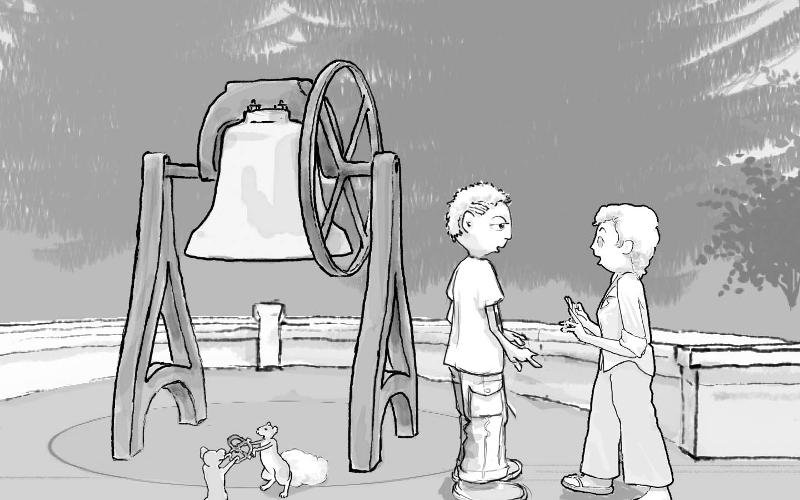
The last item on the four-part list of skills for time management is avoiding pitfalls. To a great extent, avoiding pitfalls amounts to avoiding procrastination and time wasters, as well as ways to make study time more effective and efficient.
[top of page]
If you were to monitor your time for a day you would be sure to find at least one, or maybe even more, time wasters. A time waster is something that occurs in the day that is not necessary to your day; if it did not occur, you could have probably gotten something else done in its place. A time waster prevents you from accomplishing some goal. The two main time wasters are watching television and talking on the phone. It is important to recognize time wasters so that you can make good use of your time. What are some of your favorite ways to waste time?
[top of page]
If you have ever said one of the above or something quite similar, you have most likely been dealing with procrastination.
What is procrastination?
Procrastination is the avoidance of doing a task, which needs to be accomplished. It has a high potential for painful consequences. This can lead to feelings of guilt, inadequacy, depression, and self-doubt among students. It interferes with the academic and personal success of students.
Why do students procrastinate?
Procrastination means not managing your time wisely. You may be uncertain of your priorities, goals, and objectives. Therefore, you keep putting off your academic assignments to a later date. Students also procrastinate because of personal problems, boring tasks, fear of failure, unrealistic expectations, and perfectionism. You may have difficulty concentrating, and waste time daydreaming and staring into space instead of completing the task. You could be overwhelmed with the task and afraid of getting a failing grade. As a result, you spend a great deal of time worrying about your upcoming exams, papers and projects, rather than completing them.
Overcoming procrastination
A helpful activity is to seriously look at the ways you procrastinate. Everyone has their own techniques and tricks for avoiding things they don't want to do.
Take a few minutes and list the ways you procrastinate. Tape the list above your computer as a reminder. Or give the list to a friend and ask him/her to tell you when they see you avoiding an assignment or neglecting to study for an exam.
|
My Favorite Ways to Procrastinate: |
Deena: Brian, I haven't seen you for a few days. How are things going?
Brian: Well, Deena, those time management tips have been really helpful. I'm not feeling nearly as stressed, and I think I am actually getting more done. I think the group could benefit from some time management too - especially now that we are doing our data collection and preparing to go into the analysis stage.
In this tutorial, you learned about the four steps which can help develop time management skills:
On average you need to spend two to three hours outside of class for every hour in class. This means you would spend forty-five hours per week on your classes if you had a fifteen-credit semester. In addition, you will have other demands for your time, such as a part-time job, family responsibilities, extra-curricular activities, and so on.
Hopefully you can answer positively to all, or at least almost all, of the following questions. When managing time, the overall goal is personal effectiveness rather than the time management strategy you have chosen as your own. If you have a style for managing time that is different from anyone else's, then more power to you for being original. Hopefully, the ideas presented in this tutorial, have supplemented or greatly improved your time management skills. Here are some things to think about to help you evaluate your time management strategies:
A few words of wisdom as you leave this section on managing time:
And so,
The following are the assignments embedded in the Time Management tutorial:
This tutorial is related to other tutorials on personal effectiveness, including note taking, active reading, active listening, and plannig your time.
Therefore, it is recommended that instructors introduce these tutorials to students in conjunction with other personal effectiveness tutorials.
[top of page]
Long-term Goals Activity
If possible, refer students back to the Writing and the College Experience iStudy Tutorial. Ask them to think about how they might change those goals in light of their college experience up to this point. To review, the autobiography asked the student to reflect upon:
If students are having trouble with determining goals, the instructor may want to help them by providing examples of possible goals.
Break the students up into small (four-five people) groups. Have each individual discuss his or her long-term goals with the group. The other group members should provide constructive feedback to the individual. Instructors can prompt the groups when needed, referring to the Key Points section as needed.
Individuals can present their findings to the class and be prepared to discuss them. Instructors can assess students' understanding of setting long-term goals at this point by observing how each individual presents his or her findings and responds to questioning.
Note : This is an excellent opportunity to use and reinforce the cooperative learning techniques found in the Cooperative Learning Tutorial. Also, this activity may be completed asynchronously; instructors do not need to be face-to-face with the students. After receiving the initial assignment, students can use electronic resources to complete the assignment.
Identifying and Overcoming Obstacles Activity
Small Group Activity
Have students share their goals in small groups. As a group, students could brainstorm possible obstacles for each group member's goals. See Long-term Goals Activity above for details on how to structure this activity.
Master Calendar Activity
After having the students use this iStudy tutorial on creating a master calendar, the instructor should require students to attend an in-class session to discuss the tutorial exercise and construct a personal master calendar for the semester.
Provide students with blank monthly master calendar sheets that have a space to put in the name of the month, and have blank boxes where students can fill in the dates for the month. Have the students fill in the month and date information for the current semester on each sheet.
Starting with the current date, have students transfer dates onto their personal calendar. Note to students that while it may seem obvious, consolidation of calendars is crucial to effectively planning their time.
Similar items should use the same color pencil - for example, all holidays should be written using a colored pencil. Have students add dates from:
Weekly Timetable Activity
Have students transfer any items which occur on a weekly basis onto the blank weekly timetable sheets. This will involve charting:
After completion of the weekly timetable, have students pair together to discuss and critique both their master calendars and their weekly timetables. Ask them to think about what they have not included, and to determine possible problems which can be seen from analyzing their calendars and timetables.
Daily "To-Do" List Activity
Have students create a list of daily activities and responsibilities on a sheet of note book paper (or some other sheet of paper). Make it clear to the students that the list can be general or detailed, but that the important thing is that they have a list.
Important points to make about writing to-do lists:
Have students create a to-do list for the next few days (perhaps the next seven days) and share these with one another in pairs. Ask students to critique each to-do list and identify missing items or possible problems.
After completing the activity, remind students to use their to-do lists over the next seven days. Students should reflect in their journals on how accurate the list was, and how helpful they found it to be in using their time effectively.
Avoiding Pitfalls/Study Tips Activity
This activity is designed to help students to see how they procrastinate, how to avoid and overcome procrastination, and how to effectively use their study time.
The instructor may want to begin by saying something like:
The instructor should have the class brainstorm ways to procrastinate. Have students write down their favorite ways to procrastinate, and then create a class list of top procrastination techniques
Next, have the class brainstorm ways to avoid each of the procrastination techniques.
Some ways to avoid procrastination are:
Finally, generate tips for studying with the class:
[top of page]
These points are covered in this iStudy tutorial, but should be emphasized in any discussions.
Instructors may want to emphasize the total study time one should spend just on class work:
On average you should spend two to three hours outside of class for every hour in class. This means you would spend forty-five hours per week on your classes if you had a fifteen-credit semester. In addition, you will have other demands for your time, such as a part-time job, family responsibilities, extra-curricular activities, and so on.
Share with the students six steps which can help develop time management skills:
[top of page]
Through observing both the group's and the individual's activity, the instructor may assess student performance. Assessment criteria are as follows (Instructors supply the percentage weights):
|
Where |
Domain |
Activities |
% |
|---|---|---|---|
|
iStudy Tutorial |
Knowledge |
The student can identify common mistakes and pitfalls when managing time by listing them. The student can lay out timetable for a given period of time. |
|
|
iStudy Tutorial |
Comprehension |
The student can determine goals by relating to a given period of time. |
|
|
In-class |
Application |
The student can develop a timetable and "To Do" list for a semester or several months. |
|
|
iStudy Tutorial |
Analysis |
The student can prioritize his or her time by breaking it down into weekly and daily tasks. |
|
|
|
|
|
100% |